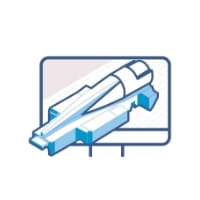Select a domain
I agree to Skill-Lync terms & conditions and privacy policy.
Job Trends In The CAD (Computer-Aided Designing) Industry
Engineers have discovered a new way to develop digital 2D and 3D models as the world has gone digital. The CAD technology has allowed design engineers to create and modify the designs and analyse their performance in real-time without creating the prototype.
Job Trends In The CAD (Computer-Aided Designing) Industry

Engineers have discovered a new way to develop digital 2D and 3D models as the world has gone digital. The CAD technology has allowed design engineers to create and modify the designs and analyse their performance in real time without creating the prototype. Computer-Aided Designing is the process of using software tools like AutoCAD to generate CAD models.
The CAD technology has eliminated the need for manual drawing, which made it extremely difficult to make design alterations. Manufacturing engineers must understand the CAD models to build a component that meets the standard requirement. The CAD model can represent the dimension, tolerance and other details of a component in an effective manner.
Manufacturing industries use CAD softwares to reduce the time and cost of developing and documenting. The R&D engineers can create robust designs by considering manufacturability. It can lead to innovative designs by offering flexibility in choosing the material and creating better features.
Types of Computer-Aided Design Courses
_1682509434.png)
Top OEMs are constantly finding ways to improve their products' quality cost-effectively. Prospective employers prefer candidates with advanced certification courses in Computer-Aided Design who can become an asset to the organisation from day one of their work.
Below are the three popular types of courses for CAD training
CAD Analysis Training By Colleges/Universities
Computer-Aided designing is a vast concept in mechanical engineering which covers many technicalities involved in designing a hardware part or component. The engineering colleges offer courses for a few semesters for the student to understand engineering drawings. The NPTEL website also provides a free CAD course without certification, an initiative by prestigious universities IITs and IISc. Nonetheless, the certification can be obtained for INR 1,000/course with an examination.
CAD Online Course By EdTech Companies
Skill-Lync is a pioneer in providing advanced engineering courses for mechanical engineers. Our unique pedagogy and project-based curriculum will equip students with the key technical skills to pursue a promising career. The Post Graduate Program in CAD offered by Skill-Lync teaches industry-standard practices to students and empowers them to become industry-ready professionals.
We offer an NSDC-accredited CAD design course through which aspirants can build expertise in CAD tools and become eligible for high-paying jobs at top OEMs.
CAD Training Through Internships
Engineers need to gain industrial exposure during their coursework to gain an advantage in the competitive job market. Working on industrial projects and pursuing internships can help you to gain relevant work experience. We provide internship opportunities for eligible students through our CAD certificate courses. You can develop a strong foundation in theoretical and practical knowledge through our course.
Specialisations in Computer-Aided Designing Courses

Skill-Lync offers expert-curated CAD training with mentorship support to ensure you completely understand the technical concepts. We know the growing industry demands well and equip students with the most in-demand skill sets. Following are the specialised course taught in the PG program.
- Ultimate SOLIDWORKS Course
- Automotive Sheet Metal Design using Siemens NX CAD / CATIA V5
- Automotive BIW Fixture Design using CATIA V5
- Automotive Seating Design using CATIA V5
Ultimate SOLIDWORKS Course
SOLIDWORKS is one of the most popular softwares used by design engineers for solid modelling. This machine design course will provide you with training in SOLIDWORKS and teaches the techniques involved in surface modelling. The course will take you through advanced sketching and solid modelling methods.
Automotive Sheet Metal Design using Siemens NX CAD / CATIA V5
Engineers create sheet metal models to build the body of the vehicles. It is important to understand the properties of sheet metal and develop an automotive body that is lighter in weight and resistant to plastic deformation. Our NX CAD software course will provide you with the necessary skills to design the tailgate, fender, roof and other automotive body parts.
Automotive BIW Fixture Design using CATIA V5
BIW is a stage in the automotive development where different body parts are welded together using metal joining methods. These design courses for mechanical engineers will teach you the basic terminologies and GD&T concepts involved in BIW designing. Our industry experts will teach you to use CATIA V5 to design a robot and manual welding fixture.
Automotive Seating Design using CATIA V5
While building a passenger car, a design engineer must consider the passenger's comfort and the driver's ergonomics. This CATIA V5 course is well-structured by our experts to introduce you to the different components and design considerations involved in seating design.
Cost and Duration of CAE Certification Courses
The cost of the CAD classes at Skill-Lync varies depending on the curriculum and program duration.
The fee structure of this CAD design course has been divided into three categories: basic, pro, and premium.
Investing your time and money to acquire advanced skill sets can prepare you for a lucrative career. Through this Computer-Aided Engineering course, one can get ready for the following jobs:
Job Opportunities After CFD Certification Courses:
- Sheet Metal Design Engineer
- Design Engineer
- New Product Development Engineer
- CAD Engineer
- Seating Design Engineer
- Wiring Harness Engineer
Higher Education After CAD Training
In a rapidly growing tech landscape, continual learning and skill development are recommended. Those who are interested in higher education after the CAD coursecan easily consider the following post-graduate programmes:
- Master’s in Design Engineering
- Master’s in Automotive Engineering
- Master’s in CAE
Related Courses



